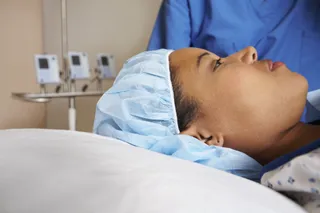Understanding Aggressive Forms of Breast Cancer
Learn about inflammatory and triple-negative breast cancer.

1 / 10
Why This Matters to Us - Black women are no strangers to developing aggressive breast cancers — both inflammatory and triple-negative. These cancers are harder to treat and impact our survival rates. Read more about the types of aggressive cancers out there, how they impact Black women and new treatment developments. —Kellee Terrell(Photo: Zave Smith/Image Source/Corbis)

2 / 10
Black Women and Aggressive Breast Cancer - A North Carolina Breast Cancer Study found that triple-negative breast cancer was much higher among younger African-American women than in white women (39 percent for Blacks versus 16 percent for whites). Also, 10 percent of Black women have inflammatory breast cancer compared to 1-5 percent of white women. Obesity is linked to these cancers and younger Black women — 35 and younger — are vulnerable to these cancers as well. (Photo: LWA/Dann Tardif/Blend Images/Corbis)

3 / 10
What’s Inflammatory Breast Cancer? - It’s a rare form of breast cancer that accounts for less than 5 percent of all breast cancer diagnoses. It blocks the vessels in the skin that carry lymph fluid throughout the body. This form of cancer causes the breasts to look swollen and red.(Photo: Artiga Photo/Corbis)
Photo By Photo: Artiga Photo/Corbis

4 / 10
Inflammatory Breast Cancer Symptoms - Patients with inflammatory breast cancer may experience red and swollen breasts, bruised skin around the breasts, swollen lymph nodes in underarms, burning sensations and increased breast size. The skin may also look pitted like an orange because the fluid is all backed up and the nipple may also face inward.(Photo: Corbis)

5 / 10
How Serious Is It? - Very. Women diagnosed with this form do not live as long as women with other types of this disease. Inflammatory breast cancer can develop and progress in a few weeks or months. For many women, when they are diagnosed with this form, they are already in stage III or IV, and the cancer may have spread to other lymph nodes or other parts of the body.(Photo: Odilon Dimier/PhotoAlto/Corbis)
ADVERTISEMENT

6 / 10
Treatment Options - Even though it can be harder to treat, usually the first step is chemotherapy — drug treatment that uses powerful chemicals to kill fast-growing cells — then surgery to remove the tumors, followed up with radiation therapy. There has been a call by many researchers to get more funding to advance the current treatment. (Photo: Fabio Cardoso/Corbis)

7 / 10
What Is Triple-Negative Breast Cancer? - This form of cancer lacks the most common receptors that fuel most breast cancer growth — estrogen, progesterone, and the HER-2/neu gene — making it “triple negative.” Because these tumors lack these receptors, it’s harder to treat this form of cancer with the traditional hormone therapy. This cancer accounts for 10-20 percent of all diagnoses. (Photo: Jose Luis Pelaez, Inc./Blend Images/Corbis)

8 / 10
Triple-Negative Breast Cancer Symptoms - This particular cancer doesn’t really look much different from other forms; it just has some different characteristics. Testing will only tell you if have this form. (Photo: Isaac Lane Koval/Corbis)

9 / 10
How Serious Is It? - Pretty serious: This cancer has a low, five-year survival rate. This is because triple-negative breast cancer can be more aggressive and difficult to treat. Also, the cancer is more likely to spread and reoccur. (Photo: Michael Poehlman/Getty Images)
